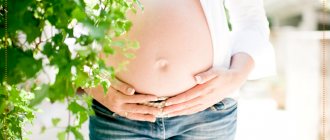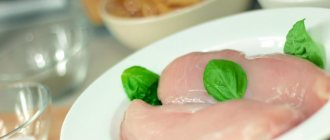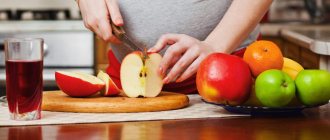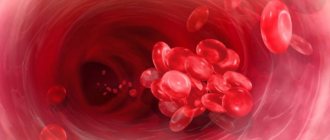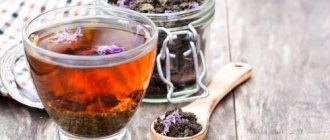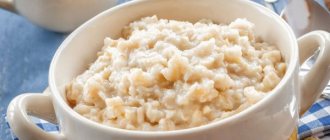During pregnancy, some women experience increased blood viscosity. Sometimes this is a completely natural reaction of her body to taking iron-containing drugs, and the thickness of the blood does not reach a dangerous level.
But if the values are too high, then quite severe pathologies of the blood vessels and heart can develop. In extreme cases, a diagnosis of “increased coagulation” threatens miscarriage or premature birth.
The doctor decides how great the danger is and what kind of treatment is needed. But in absolutely all cases, it will not hurt to adjust the diet in favor of choosing foods that help thin the blood.
Signs of increased blood viscosity during pregnancy
The doctor can see exact indicators of increased coagulability only from the results of a blood test such as a coagulogram. But already at the stage of taking a general blood test, the laboratory assistant may see external signs of this deviation. For example, obstructed blood flow into the syringe and even blockage of the needle.
But there are other external signs that the expectant mother’s blood may be too thick:
- swelling and heaviness in the legs;
- dry mucous membranes in the mouth;
- freezing limbs;
- low tone of the whole body;
- decreased concentration;
- constipation, sluggish bowels.
All these signs may not indicate problems with the blood .
Moreover, they can go away without consequences after childbirth. But it is better to be vigilant and tell your doctor about these health problems.
Folk remedies
Traditional medicine recipes for blood thinning during pregnancy should also be treated with caution. Some components of this or that product may be acute allergens. Individual intolerance may become apparent already during the “therapeutic” course, in which case the use must be stopped.
You can use one of the following recipes:
Sweet clover: a tablespoon of dry herb per glass (250 ml) of boiling water. Leave for at least one hour, then strain. Take 100-130 ml before meals. The finished infusion can be stored in the refrigerator for a maximum of two days.
Garlic and honey: two cloves are crushed and mixed with 300 gr. liquid natural honey. Everything is thoroughly mixed and infused for three weeks. Take a tablespoon 20-30 minutes before meals.
Drink: a tablespoon of green tea, a small piece of ginger root and a pinch of cinnamon. Everything is mixed, 0.5 liters are poured. boiling water Before use, you can add lemon and natural honey.
Why is this dangerous?
In addition to the above-mentioned signs of developing pathology, too thick blood can lead to consequences in the form of serious and dangerous diseases. Of course, not in all cases, but often due to a long period of increased coagulability, pathologies such as:
- varicose veins, thrombosis and thrombophlebitis;
- pulmonary embolism;
- hypertension and atherosclerosis.
- heart attack and stroke.
It is because of inattention to blood thickening during pregnancy after childbirth that a woman discovers swollen veins, which are not easy to treat.
But even if a woman is not diagnosed with these serious diseases, the child in the womb may also suffer. For him, increased blood viscosity is dangerous because of what can happen:
- fetal hypoxia;
- delay in the development of the child or frozen pregnancy;
- miscarriage at any stage.
Therefore, you should not think that swelling accompanies any pregnancy, and not worry about its causes. Each such small deviation in well-being can mean increased blood density, which is fraught with serious consequences.
General rules
All processes occurring in the cells of our body depend on blood viscosity indicators. After all, its main function is to transport nutrients, respiratory gases, hormones and much more. When the properties of the blood change (thickening, acidification, increased cholesterol or sugar levels), its transport function is disrupted and the course of processes in all organs changes.
Predisposing factors for increased blood viscosity development are:
- an increase in the number of red blood cells, platelets and hemoglobin levels;
- increased blood clotting;
- insufficient fluid intake and dehydration;
- blood loss;
- impaired absorption of water in the large intestine;
- acidification of the body;
- lack of vitamins and minerals involved in the synthesis of enzymes and hormones ; large amounts of sugar and carbohydrates in the diet.
Hyperviscosity syndrome leads to the fact that blood cells cannot perform their functions (for example, transport), and organs do not receive enough necessary substances and do not get rid of breakdown products. Thick blood is difficult for the heart to push through the vessels, it is prone to the formation of thrombosis and a person develops various pathological conditions and diseases.
The most dangerous consequences are the tendency to form blood clots . More often, coronary and cerebral vessels become thrombosed with the development of myocardial infarction and ischemic stroke . It is also possible to develop hypertension , atherosclerosis , intracerebral and subdural bleeding. Timely detection of increased blood viscosity (complete blood count, hematocrit , coagulogram ) allows timely treatment and nutritional adjustments to avoid serious complications.
An insufficient amount of amino acids in the diet, proteins, trace elements and unsaturated fatty acids causes an increase in blood viscosity. Based on this, the main food products for this condition will be: sea fish, lean meat, seaweed, eggs, olive, flaxseed oil, dairy products. Anticoagulants include products containing salicylic acid , iodine, vitamin E and omega-3 fatty acids.
A blood thinner diet must contain some important micronutrients that affect platelet .
Magnesium
The negative consequences of deficiency are increased platelet aggregation and excessive thrombus formation. Human nutrition is characterized by excessive salt intake and a deficiency of potassium and magnesium, so magnesium deficiency is quite common. Since it enters the body with food and water, a diet enriched with magnesium is therefore recommended (sesame seeds, pumpkin seeds, wheat bran, rice, oatmeal, avocado, yoghurt, seaweed, prunes).
When compiling a diet, you need to take into account not only its quantity, but also its bioavailability. The maximum amount of magnesium is contained in fresh vegetables, fruits and nuts (new harvest only). When preparing products (drying, canning, drying), the concentration of this element decreases slightly, but the bioavailability is greatly reduced. There are natural mineral waters rich in magnesium: “Batalinskaya”, “Donat”, Kislovodsk Narzans, waters of Pyatigorsk (Lysogorskaya).
Potassium
Plant foods rich in potassium: raisins, nuts, pumpkin, baked potatoes, seaweed, sardines, prunes, apricots, lean meat.
Iron
Low levels increase the risk of blood clots. Contained in many cereals, vegetables and herbs, meat products and offal (liver). The parallel consumption of foods rich in ascorbic acid (sweet and sour berries, citrus fruits, kiwi, bell peppers, legumes) accelerates the absorption of iron.
Vitamin C
Strengthens the walls of blood vessels and reduces the risk of blood clots. The most effective in thickening the blood is tomato and tomato juice. For prevention purposes, the diet should include lemons, eggplants, onions, cucumbers, lettuce, zucchini, turnips, and squash. However, vitamin C should be supplied within normal limits, since an excess of it increases viscosity.
Omega-3 PUFAs
They have anti-inflammatory, antioxidant and antithrombotic effects. Positive effects are associated with their ability to cause vasodilation, reduce platelet activity, rheological properties of blood and the tendency to thrombus formation. Their required amount in the diet ranges from 0.5-1 g/day.
The high content of these acids is in sardines, anchovies, herring, mackerel, halibut, flaxseed, rapeseed, soybean, mustard, nut, sesame vegetable oils, fish oil, various nuts and seeds. Eating fish even once a week reduces the risk of blood clots by 30-45%, while eating red fried meat doubles this risk.
Amino acid taurine
Helps thin the blood. Most of it is found in unrefined, cold-pressed vegetable oil (flaxseed or olive), shrimp, squid, tuna, shellfish, and flounder. It will be sufficient to consume 200 g of seafood 3 times a week.
Arginine
It has a vasodilating effect and reduces platelet aggregation. It is enough to eat 30 g of nuts daily to reduce blood clotting. Nuts (pine nuts, almonds, cashews) also contain a large amount of protein and microelements.
Iodine
Contained in sea fish, seaweed, shrimp, sea cucumbers, and mussels. This element not only normalizes blood viscosity, but also reduces the risk of atherosclerosis . Ready-made seaweed salads contain a lot of salt, vinegar and spices; it is better to buy dried and cook at your own discretion, or add ground seasoning to all dishes.
Salicylates
Contains strawberries, gooseberries, raspberries, cranberries, cherries, citrus fruits (primarily lemons), apples, prunes, currants (white, red), cucumbers, tomatoes, red peppers, beets, onions, garlic, dark grapes, dry red wine.
Summarizing the above, we can make a list of food products that thin the blood:
- lemon;
- garlic, onion;
- tomatoes (tomato juice);
- artichoke;
- Jerusalem artichoke;
- beet;
- cucumbers;
- ginger;
- cinnamon;
- fish (trout, mackerel, herring, sardine, salmon) and fish oil;
- Apple vinegar;
- olive, flaxseed, rapeseed, nut, sesame oil;
- almond;
- hazelnut;
- sunflower seeds;
- oatmeal, oat flakes;
- bitter chocolate;
- cocoa;
- cherries, raspberries, strawberries, pineapple, cranberries, gooseberries, lingonberries, dark grapes, currants, strawberries, blueberries, melon, citrus fruits, apricots, figs, peaches, apples.
Try not to overuse salt, include ginger tea, fresh fruits and vegetables in your diet. Natural grape juice (from red grape varieties), juices from orange, lemon, tomatoes, and cranberries are especially useful.
Excess weight is considered a factor predisposing to increased blood clotting. In this regard, it is important to reduce the calorie content of food (1700 kcal/day) by eliminating refined carbohydrates (sugar, confectionery, jam, candy, etc.).
How to behave?
As soon as the expectant mother suspects that she has problems with blood thickness, she urgently needs to see a doctor. In no case should you self-medicate, because:
- pregnancy is a complex and unpredictable condition, so you need to approach your health with caution, trying first and foremost not to cause harm;
- self-medication or some folk methods may not be enough; drug treatment may also be necessary; otherwise, the problem will only be disguised, but will not go away;
- The degree of development of the disease can only be diagnosed using laboratory methods; before treatment, most likely, there will be a need to undergo additional medical examinations, which can only be prescribed by a doctor;
- some concomitant diseases require an individual approach and their own treatment regimen;
- a certain time before the expected birth, it is necessary to stop treatment in order to avoid complications during childbirth.
After consulting a doctor, she will also need to adjust her lifestyle. After discussing treatment options with your doctor, it is important to find out whether you can:
- increase the volume of liquid you drink (you need to remember that you need to drink water in small portions throughout the day, and not divide the entire norm by 2-3 times);
- move more: walk, walk, do light exercises;
- introduce some foods into your diet while limiting others.
Fully or partially limited products
In case of thick blood, the following is limited or excluded:
- consumption of saturated fats (cooking fats, lamb, pork, beef);
- fatty varieties of pork, duck, goose, smoked meats and sausages;
- all types of broths, fried foods;
- fatty cottage cheese, sour cream, cheese, butter, cream;
- sweet pastries, sugar, puff pastry and pastry products, cakes, pastries with cream;
- black tea, green tea, coffee;
- salt;
- buckwheat;
- legumes (mature legumes are allowed in limited quantities);
- kidneys, liver (beef/pork), brains;
- white bread;
- all types of cabbage, radishes, turnips, radishes, watercress;
- dill, basil, parsley, coriander (greens);
- blueberries, chokeberries, mulberries, dogwoods, lingonberries, blackberries, viburnum;
- pomegranate juice, light grape juice.
vitamin K first : green leafy vegetables, green tea and black tea, kale, cilantro, beet tops, chard, broccoli, Brussels sprouts, pumpkin, asparagus, kiwi, green beans, cauliflower cabbage, soybeans, walnuts, eggs, pork liver.
Cereals include buckwheat and whole grain bread. Green peas, beans, asparagus, cucumbers, soybeans, green onions, avocado, papaya, and green tomatoes contain this vitamin in much smaller quantities. Meat, eggs, dairy products, cereals, root vegetables (potatoes, beets) contain negligible amounts of it.
Decoctions of the herbs nettle, St. John's wort, yarrow, valerian, and corn silk help thicken the blood.
Table of prohibited products
| Proteins, g | Fats, g | Carbohydrates, g | Calories, kcal | |
Vegetables and greens | ||||
| greenery | 2,6 | 0,4 | 5,2 | 36 |
| beans | 6,0 | 0,1 | 8,5 | 57 |
| cabbage | 1,8 | 0,1 | 4,7 | 27 |
| broccoli | 3,0 | 0,4 | 5,2 | 28 |
| boiled cauliflower | 1,8 | 0,3 | 4,0 | 29 |
| parsley | 3,7 | 0,4 | 7,6 | 47 |
| radish | 1,2 | 0,1 | 3,4 | 19 |
| white radish | 1,4 | 0,0 | 4,1 | 21 |
| red radish | 1,2 | 0,1 | 3,4 | 20 |
| black radish | 1,9 | 0,2 | 6,7 | 35 |
| salad | 1,2 | 0,3 | 1,3 | 12 |
| celery | 0,9 | 0,1 | 2,1 | 12 |
| soybeans | 34,9 | 17,3 | 17,3 | 381 |
| asparagus | 1,9 | 0,1 | 3,1 | 20 |
| dill | 2,5 | 0,5 | 6,3 | 38 |
| beans | 7,8 | 0,5 | 21,5 | 123 |
| lentils | 24,0 | 1,5 | 42,7 | 284 |
| spinach | 2,9 | 0,3 | 2,0 | 22 |
| sorrel | 1,5 | 0,3 | 2,9 | 19 |
Fruits | ||||
| avocado | 2,0 | 20,0 | 7,4 | 208 |
| bananas | 1,5 | 0,2 | 21,8 | 95 |
| pomegranate | 0,9 | 0,0 | 13,9 | 52 |
| dogwood | 1,0 | 0,0 | 10,5 | 44 |
| mango | 0,5 | 0,3 | 11,5 | 67 |
| mulberry | 0,7 | 0,0 | 13,6 | 52 |
Berries | ||||
| cowberry | 0,7 | 0,5 | 9,6 | 43 |
| grape | 0,6 | 0,2 | 16,8 | 65 |
| blueberry | 1,0 | 0,0 | 8,2 | 35 |
| blackberry | 2,0 | 0,0 | 6,4 | 31 |
| viburnum | 0,0 | 0,0 | 7,0 | 26 |
| Red currants | 0,6 | 0,2 | 7,7 | 43 |
| black currant | 1,0 | 0,4 | 7,3 | 44 |
| chokeberry | 1,5 | 0,2 | 10,9 | 55 |
Mushrooms | ||||
| mushrooms | 3,5 | 2,0 | 2,5 | 30 |
Cereals and porridges | ||||
| buckwheat (kernel) | 12,6 | 3,3 | 62,1 | 313 |
| semolina | 10,3 | 1,0 | 73,3 | 328 |
| white rice | 6,7 | 0,7 | 78,9 | 344 |
Flour and pasta | ||||
| pasta | 10,4 | 1,1 | 69,7 | 337 |
Confectionery | ||||
| jam | 0,3 | 0,2 | 63,0 | 263 |
| jam | 0,3 | 0,1 | 56,0 | 238 |
| candies | 4,3 | 19,8 | 67,5 | 453 |
| pastry cream | 0,2 | 26,0 | 16,5 | 300 |
| cookie | 7,5 | 11,8 | 74,9 | 417 |
Ice cream | ||||
| ice cream | 3,7 | 6,9 | 22,1 | 189 |
Cakes | ||||
| cake | 4,4 | 23,4 | 45,2 | 407 |
Chocolate | ||||
| chocolate | 5,4 | 35,3 | 56,5 | 544 |
Raw materials and seasonings | ||||
| mustard | 5,7 | 6,4 | 22,0 | 162 |
| mayonnaise | 2,4 | 67,0 | 3,9 | 627 |
Dairy | ||||
| milk 3.6% | 2,8 | 3,6 | 4,7 | 62 |
| milk 4.5% | 3,1 | 4,5 | 4,7 | 72 |
| cream | 2,8 | 20,0 | 3,7 | 205 |
| sour cream 25% (classic) | 2,6 | 25,0 | 2,5 | 248 |
Cheeses and cottage cheese | ||||
| cheese | 24,1 | 29,5 | 0,3 | 363 |
| cottage cheese 11% | 16,0 | 11,0 | 1,0 | 170 |
| cottage cheese 18% (fat) | 14,0 | 18,0 | 2,8 | 232 |
Meat products | ||||
| pork | 16,0 | 21,6 | 0,0 | 259 |
| pork liver | 18,8 | 3,6 | 0,0 | 108 |
| pork kidneys | 13,0 | 3,1 | 0,0 | 80 |
| pork fat | 1,4 | 92,8 | 0,0 | 841 |
| salo | 2,4 | 89,0 | 0,0 | 797 |
| beef liver | 17,4 | 3,1 | 0,0 | 98 |
| beef kidneys | 12,5 | 1,8 | 0,0 | 66 |
| beef brains | 9,5 | 9,5 | 0,0 | 124 |
Sausages | ||||
| smoked sausage | 16,2 | 44,6 | 0,0 | 466 |
| smoked sausage | 9,9 | 63,2 | 0,3 | 608 |
| sausages | 10,1 | 31,6 | 1,9 | 332 |
| sausages | 12,3 | 25,3 | 0,0 | 277 |
Bird | ||||
| smoked chicken | 27,5 | 8,2 | 0,0 | 184 |
| duck | 16,5 | 61,2 | 0,0 | 346 |
| smoked duck | 19,0 | 28,4 | 0,0 | 337 |
| goose | 16,1 | 33,3 | 0,0 | 364 |
Fish and seafood | ||||
| smoked fish | 26,8 | 9,9 | 0,0 | 196 |
| salted fish | 19,2 | 2,0 | 0,0 | 190 |
| Red caviar | 32,0 | 15,0 | 0,0 | 263 |
| black caviar | 28,0 | 9,7 | 0,0 | 203 |
| canned fish | 17,5 | 2,0 | 0,0 | 88 |
Oils and fats | ||||
| butter | 0,5 | 82,5 | 0,8 | 748 |
| animal fat | 0,0 | 99,7 | 0,0 | 897 |
| cooking fat | 0,0 | 99,7 | 0,0 | 897 |
Non-alcoholic drinks | ||||
| instant coffee dry | 15,0 | 3,5 | 0,0 | 94 |
| green tea | 0,0 | 0,0 | 0,0 | — |
| black tea | 20,0 | 5,1 | 6,9 | 152 |
| * data is per 100 g of product | ||||
What should you avoid?
There are a number of products that are, in principle, useful for a pregnant woman and her baby. But in a particular case, their use may be worth limiting, as they lead to increased clotting .
This is food like:
- bananas;
- potatoes in any form;
- chokeberry;
- buckwheat in the form of milk porridge or side dish.
But in any case, you need to exclude things that can provoke increased clotting, even if the pregnant woman loves such foods:
- salted or pickled vegetables;
- fatty meat and liver;
- fatty dairy products;
- fried foods;
- white flour bread, baked goods;
- cookies and sweets prepared with the addition of refined sugar;
- store-bought lemonades, even if they are not with sugar;
- mayonnaise and other ready-made sauces;
- strong tea and coffee;
- semi-finished products, chips, salted nuts, etc.
Authorized Products
The diet for thick blood includes:
- Replacing meat products with fish and seafood and providing the body with a sufficient amount of polyunsaturated fatty acids contained in sea fish. The basis of the weekly diet should be fish and seafood dishes. Give preference to fatty sea fish - salmon, trout, tuna, mackerel, herring, salmon, sardines, saury. It is enough to include 100-150 g of fish in the diet 3 times a week. A useful addition would be seaweed, which can also be eaten dried.
- Introducing omega-3 fatty acids into the diet in the form of flaxseed, olive, rapeseed, mustard, nut, and sesame vegetable oils, which should be consumed in their natural form and not in heat-treated form.
- Include at least 200 g of fresh fruits and 400 g of vegetables daily. You can eat red grapes, cherries, raspberries, strawberries, citrus fruits, tomatoes, red peppers, cucumbers - they contain a small amount of vitamin K.
- Strawberries, gooseberries, cranberries, raspberries, cherries, beets, onions, garlic, citrus fruits (lemons come first), apples, prunes are rich in salicylates.
- Prepare a side dish for meat and fish from carrots, zucchini, and eggplant. If you use potatoes, it is better in the peel and baked form.
- To vegetable salads, add herbs, bran, fenugreek, sesame and flax seeds, ground in a coffee grinder.
- Vegetable soups, cabbage soup, beetroot soup, borscht. Eliminate meat broths and do not fry soups.
- Eating low-fat meat and poultry - it is enough to include them in the diet 2 times a week.
- Turkey meat is healthy (it contains very little fat).
- Rye and bran bread. It is better to add flax seed, bran or sesame to homemade baked goods.
- Low-fat milk and fermented milk products. Use sour cream and cream only in dishes. You can include up to 4 eggs in your weekly menu.
- Eating oatmeal, corn, pearl barley, wheat and brown rice. Porridge can be cooked with water or milk.
- The most important feature of the diet of people prone to blood thickening is sufficient consumption of high-quality drinking water. With limited intake of water into the body, blood thickening is observed.
- Herbal teas (licorice, hawthorn, hazel leaves, sweet clover, sage) with lemon, ginger tea, citrus juices, any still water are useful. The amount of liquid you drink should be 1.5-2 liters per day.
Table of permitted products
| Proteins, g | Fats, g | Carbohydrates, g | Calories, kcal | |
Vegetables and greens | ||||
| eggplant | 1,2 | 0,1 | 4,5 | 24 |
| zucchini | 0,6 | 0,3 | 4,6 | 24 |
| bulb onions | 1,4 | 0,0 | 10,4 | 41 |
| carrot | 1,3 | 0,1 | 6,9 | 32 |
| cucumbers | 0,8 | 0,1 | 2,8 | 15 |
| squash | 0,6 | 0,1 | 4,3 | 19 |
| salad pepper | 1,3 | 0,0 | 5,3 | 27 |
| beet | 1,5 | 0,1 | 8,8 | 40 |
| tomatoes | 0,6 | 0,2 | 4,2 | 20 |
| Jerusalem artichoke | 2,1 | 0,1 | 12,8 | 61 |
| pumpkin | 1,3 | 0,3 | 7,7 | 28 |
| garlic | 6,5 | 0,5 | 29,9 | 143 |
Fruits | ||||
| oranges | 0,9 | 0,2 | 8,1 | 36 |
| grapefruit | 0,7 | 0,2 | 6,5 | 29 |
| pears | 0,4 | 0,3 | 10,9 | 42 |
| melon | 0,6 | 0,3 | 7,4 | 33 |
| kiwi | 1,0 | 0,6 | 10,3 | 48 |
| lemons | 0,9 | 0,1 | 3,0 | 16 |
| tangerines | 0,8 | 0,2 | 7,5 | 33 |
| nectarine | 0,9 | 0,2 | 11,8 | 48 |
| peaches | 0,9 | 0,1 | 11,3 | 46 |
| apples | 0,4 | 0,4 | 9,8 | 47 |
Berries | ||||
| cranberry | 0,5 | 0,0 | 6,8 | 26 |
| gooseberry | 0,7 | 0,2 | 12,0 | 43 |
Nuts and dried fruits | ||||
| sesame | 19,4 | 48,7 | 12,2 | 565 |
| flax seeds | 18,3 | 42,2 | 28,9 | 534 |
| fenugreek seeds | 23,0 | 6,4 | 58,3 | 323 |
| sunflower seeds | 20,7 | 52,9 | 3,4 | 578 |
| prunes | 2,3 | 0,7 | 57,5 | 231 |
Cereals and porridges | ||||
| oat groats | 12,3 | 6,1 | 59,5 | 342 |
| cereals | 11,9 | 7,2 | 69,3 | 366 |
| millet cereal | 11,5 | 3,3 | 69,3 | 348 |
| barley grits | 10,4 | 1,3 | 66,3 | 324 |
Raw materials and seasonings | ||||
| honey | 0,8 | 0,0 | 81,5 | 329 |
Dairy | ||||
| skim milk | 2,0 | 0,1 | 4,8 | 31 |
| natural yogurt 2% | 4,3 | 2,0 | 6,2 | 60 |
Cheeses and cottage cheese | ||||
| cottage cheese 0.6% (low fat) | 18,0 | 0,6 | 1,8 | 88 |
| curd tofu | 8,1 | 4,2 | 0,6 | 73 |
Meat products | ||||
| beef | 18,9 | 19,4 | 0,0 | 187 |
| rabbit | 21,0 | 8,0 | 0,0 | 156 |
Bird | ||||
| chicken fillet | 23,1 | 1,2 | 0,0 | 110 |
| turkey | 19,2 | 0,7 | 0,0 | 84 |
Fish and seafood | ||||
| fish | 18,5 | 4,9 | 0,0 | 136 |
| squid | 21,2 | 2,8 | 2,0 | 122 |
| mussels | 9,1 | 1,5 | 0,0 | 50 |
| seaweed | 0,8 | 5,1 | 0,0 | 49 |
Oils and fats | ||||
| linseed oil | 0,0 | 99,8 | 0,0 | 898 |
| olive oil | 0,0 | 99,8 | 0,0 | 898 |
Non-alcoholic drinks | ||||
| mineral water | 0,0 | 0,0 | 0,0 | — |
Juices and compotes | ||||
| Orange juice | 0,9 | 0,2 | 8,1 | 36 |
| Cherry juice | 0,7 | 0,0 | 10,2 | 47 |
| grapefruit juice | 0,9 | 0,2 | 6,5 | 30 |
| strawberry juice | 0,0 | 0,0 | 10,0 | 41 |
| cranberry juice | 0,4 | 0,3 | 11,0 | 46 |
| raspberry juice | 0,8 | 0,0 | 24,7 | 100 |
| * data is per 100 g of product | ||||
